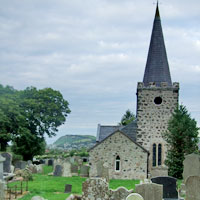
St Patrick’s Church, Cairncastle
A place of antiquity
This beautiful spot in Cairncastle parish was the site of a medieval church. The date of its foundation is not known, but it appears in the papal taxation of 1306 as Karkastell.
The seventeenth century
In the early 1600s, the new Reformed Church took ownership of medieval parish churches throughout Ireland and used them for Protestant worship. A visitation to Cairncastle in 1622 records:
“noe church, but the waln fallen to the ground; a house builded in the churchyard, at the expense of the parish, where they assemble together’”
This report suggests that the old medieval church was in a state of disrepair, and a temporary building was being used until a new church could be constructed. A later report from 1657 tells us that Cairncastle church was in repair. This probably refers to a new church, built to replace the ‘house’ of 1622.
The minister at this time was Rev. Patrick Adair. In 1661, he was deposed for his nonconformity, but he remained in the area to minister to local Presbyterians. Adair died in Belfast in 1694.
In 1679, Cairncastle church was described as ‘ruinosa’, or run down, and in 1683 it was noted that the inhabitants of the parish were ‘all Presbyterians’. That same year, a Welshman, Lemuel Matthews, was appointed minister. Jonathan Swift is reputed to have named Lemuel Gulliver, the hero of Gulliver’s Travels, after him.
We have virtually no information about the parish church in the eighteenth century. In 1768 it was described as being ‘in bad repair’, but beyond that, very little is known.
The present church
The new church was completed in 1815. Repairs in the early 1860s saw the roof replaced, roughcast removed from the walls, and smaller panes inserted in the windows. The pulpit and reading desk were moved to the east end and box pews replaced.
The east window in St Patrick’s was made by the famed Mayer Company in Munich. Its craftsmanship is of an exceptional quality, so that here in this small country church, we can enjoy one of the finest stained glass windows in Ireland.
Also of note are the two south windows in the chancel each depicting local landmarks. The St Patrick’s window shows the church’s patron Saint tending sheep on nearby Slemish mountain. The adjacent south window in the Nave window is dedicated to the memory of Captain John Park, a former ship’s master on the P&O Larne-Fleetwood ferry.
A plaque on the south wall of the nave commemorates Sir Thomas Dixon (died 1950) who together with his wife Lady Edith were generous local benefactors. They gave their former home – Cairndhu House – to be a Convalescent Hospital, donated land for the Dixon Park in Larne, founded the Dixon Church Hall in Drains Bay, and gave the Lady Dixon Park to the city of Belfast.
Further changes were made to St Patrick’s in the twentieth century. The octagonal spire was rebuilt in 1960 and a Sunday School extension added in 1993. In 2007, following major restoration, the church was rededicated by the Archbishop of Armagh, the Most Revd. Alan Harper.
One of the most interesting items in St Patrick’s is the font. A brass plate tells us it was used by Dean Swift when he was in Ballynure Church during his incumbency in 1695.
The old church
The immediate predecessor to the 1815 church lies to the north-west. Measuring approximately 16 metres by 7.5 metres, its location is marked by a depression in the surface of the churchyard. Some lengths of foundation wall are still visible and a section of the north wall survives to a height of about 3 metres.
A square walled enclosure containing the monument to the Rev. Classon Porter lies against the north wall of the old church. This enclosure may indicate the ‘house’ referred to in the 1622 visitation.
The churchyard.
This churchyard has probably been used as a place of interment since the medieval period.
One of its most interesting features is a beautiful Spanish chestnut tree, said to stand on the spot where a shipwrecked Spanish sailor was buried in the sixteenth century. It is known that Spanish sailors carried chestnuts to ward off scurvy on their long voyages.

